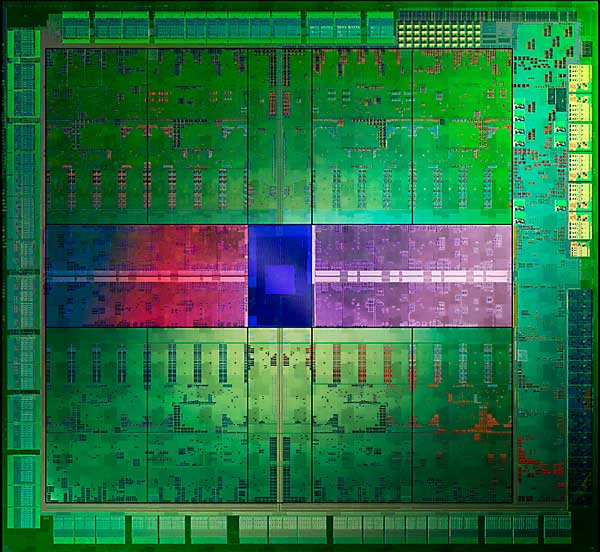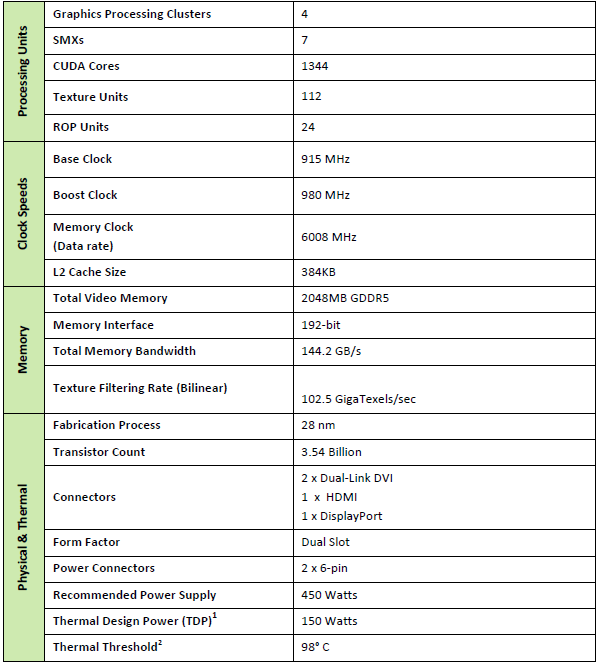Reference technology and specs
Reference technology and specs
In this segment of the article we will look at the reference (original design) based specs and architecture. The GeForce GTX 660 Ti is based on the Kepler GPU architecture. It is based on the very same 28nm GK104 GPU which is used on the GeForce GTX 670 and 680.
- The GeForce GTX 660 Ti boasts 1344 CUDA (shader) cores
- The GeForce GTX 670 boasts 1344 CUDA (shader) cores
- The GeForce GTX 680 boasts 1536 CUDA (shader) cores
And yeah that says it all right there, that's the same amount of shader cores and thus rendering engine compared to the GTX 670. It is 192 Shader cores less then 1536 and precisely one CUDA core cluster (SM) less out of the eight available. But let me first show you GK104 die where you can see the physical 8 clusters:

NVIDIA GK104 Kepler architecture GPU, you can see the eight SM (CUDA/shader core) clusters, one of these has been deactivated for the GTX 660 and 670.
An immediate difference to the GPU core versus the shader processor domain is that both will be clocked at 1:1, meaning both the core and shader domain clock in at 915 MHz. The boost clock for the reference GTX 660 cards is set at 980 MHz though that can vary a bit per card and available power envelope.
As far as the memory specs of the GTX 660 Ti and GK104 Kepler GPU are concerned, the 670 and 680 boards will feature a 256-bit memory bus connected to 2 GB of GDDR5 video buffer memory.
For the GTX 660 Ti that will be different, as a 192-bit memory bus is being used, but it remains clocked at an affective data rate of 6 Gbps. On the memory controller side of things you'll see very significant improvements as the reference memory clock is set at 6 GHz / Gbps.
This boils down to to a memory bandwidth of 192 GB/s on the 256-bit memory bus for the GTX 670 and 680 but roughly 144 GB/s for the GTX 660 Ti (which is still very sufficient). The product is obviously PCI-Express 3.0 ready and has a TDP of around 150 Watt.

The second change is the ROP engine, cut down to 24 units opposed to 32 on it's bigger brothers. With this release, NVIDIA now has the real mid-range products on its way. The new graphics adapters are of course DirectX 11.1 ready. With Windows 8, 7 and Vista also being DX11 ready all we need are more new games to take advantage of DirectCompute, multi-threading, hardware tessellation and the latest shader 5.0 extensions. For your reference here's a quick overview of some past generation high-end GeForce cards opposed to the new Kepler based GeForce GTX 680.
| GeForce GTX 480 |
GeForce GTX 580 |
GeForce GTX 660 Ti |
GeForce GTX 670 |
GeForce GTX 680 |
GeForce GTX 690 |
|
| Stream (Shader) Processors | 480 | 512 | 1344 | 1344 | 1536 | 3072 |
| Core Clock (MHz) | 700 | 772 | 915 | 915 | 1006 | 915 |
| Shader Clock (MHz) | 1400 | 1544 | - | - | - | - |
| Boost clock (Mhz) | - | - | 980 | 980 | 1058 | 1019 |
| Memory Clock (effective MHz) | 3700 | 4000 | 6008 | 6008 | 6008 | 6008 |
| Memory amount | 1536 | 1536 | 2048 | 2048 | 2048 | 4096 |
| Memory Interface | 384-bit | 384-bit | 192-bit | 256-bit | 256-bit | 256-bit |
| Memory Type | GDDR5 | GDDR5 | GDDR5 | GDDR5 | GDDR5 | GDDR5 |
For Kepler, NVIDIA kept their memory controllers GDDR5 compatible. Memory wise NVIDIA has nice large memory volumes due to their architecture, we pass 2 GB as standard these days for most of NVIDIA's series 600 graphics cards in the high range spectrum.

